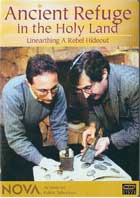
Ancient Refuge in the Holy Land: Unearthing a Rebel Hideout 2004
Distributed by WGBH Boston, 125 Western Avenue, Boston, MA 02134; 617-300-2000
Produced by Gary Hochman
Directed by Kirk Wolfinger and Gary Hochman
DVD, color, 60 min.
Jr. High - Adult
Anthropology, Jewish Studies, Middle Eastern Studies, Religious Studies
Date Entered: 04/14/2005
Reviewed by Gloria Maxwell, Reference Librarian, Penn Valley Community College, Kansas City, MOThe desert region of southern Israel is one of the most forbidding and inhospitable regions of the world. A series of caves in this region were used as hideouts and refuges for Jewish insurgents over the years. In one of the caves the famous Dead Sea Scrolls were discovered. In 1960, a very large cave was discovered by Yigael Yadin (military general and statesman of Israel) which contained letters written by the legendary Jewish hero and rebel, Bar-Kokhba. This cave became known as the Cave of Letters. With nearly 15 feet of rocks and rubble, it was impossible to excavate further. Until today….with the use of GPR (ground penetrating radar) and an endoscope, archaeologists can now penetrate the rubble and determine where to spend precious time excavating.
Two thousand years ago, Judea (now Israel), was under Roman rule. When Emperor Hadrian defiled and destroyed their most sacred site - the Temple in Jerusalem - Bar-Kokhba led rebels in a fight against Roman rule. The Emperor Hadrian was determined to erase the Jewish religion and people from history. Roman troops destroyed 900 villages and killed 600,000 people.
The Cave of Letters contains 3 chambers inside its 300 yard deep cavern. From the evidence found by archaeologists, it is now apparent that people lived here, rather than only rebels who were hiding out. It is described as a wretched place, being very hot, with no water nearby, and salt on the wall, which dries out a person’s skin. The items discovered include cloth, papyrus, a wood comb, cooking pots, a child’s sandal - all of which indicates that people lived in this cave, rather than just rebel troops hiding out. A Jewish widow’s letters have also been found which provides greater insight into this period of Jewish history. Skeletal bones for children from ages 7 to 15 show no pathology, giving further credence to the fact that women and children lived in the caves, along with the men, so that this was not just a rebel hideout. Evidence of ovens seems to indicate that Jewish people planned to live in this cave, and, therefore, must have known of its existence.
Perhaps the most mysterious items are the bronzes and ritual items that were discovered in the 1960s. The original theory was that these were Roman/pagan objects because they are decorated with motifs of pagan deities. The counter theory argues that if Bar-Kokhba had needed to melt them down for other uses, they would have been melted down. The fact that they were not leads some experts to believe that they were important to the Jews, and perhaps rescued from the Temple in Jerusalem. If this theory is ultimately proven true, it raises the greater question of why Jewish temple items would be decorated with pagan motifs. There is disagreement over whether or not this cave was used in a significant way only by Bar-Kokhba, or if it was inhabited on at least two separate occasions. Controversy exists over the results of carbon dating on various items from the cave.
This documentary does an excellent job of describing the current excavation, and presenting the several theories that surround this mysterious site and its history.
Special features on this DVD include access to the NOVA Web site and printable materials for educators. This DVD also has closed captions and described video for the visually impaired.
The technical aspects are of the highest quality, and support the high standards of NOVA programming. Maps, graphics, and simulations enhance the information delivery. An appropriate soundtrack accompanies the film.
This program is highly recommended.